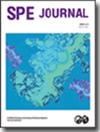Prediction of Production-Inflow Profile of a Well Producing Single-Phase Flow of Slightly Compressible Fluid from Multilayer Systems by Temperature and/or Pressure Transient Data
IF 3.2
3区 工程技术
Q1 ENGINEERING, PETROLEUM
引用次数: 0
Abstract
This study focuses on the prediction of the production-inflow profile of a well producing a single-phase flow of slightly compressible fluid (water or oil flow) in a multilayered system using the layer permeability and skin values estimated by history matching spatial and temporal temperature and/or pressure data sets along the completion interval. Such data may be acquired by wireline formation testing, production-logging-tool (PLT), or distributed temperature sensing (DTS) fiber-optic cables. We use an in-house thermal, transient coupled reservoir/wellbore simulator developed during this study. It solves transient mass, momentum, and energy conservation equations simultaneously for both reservoir and wellbore. The effects of the Joule-Thomson (J-T), adiabatic expansion, conduction, and convection are all included for predicting the flow profiles across the wellbore. The results from our in-house simulator are verified with the results from a commercial simulator for the single-phase fluid flow of a vertical well producing geothermal brine and oil in a two-zone multilayer system. We also compare the results from our rigorous transient coupled wellbore/reservoir model with the results from a model assuming steady-state thermal wellbore model used in the previous studies. We find that the steady-state thermal wellbore model used in the previous studies that ignore accumulation terms in mass, momentum, and thermal energy balances is a reasonably accurate model for predicting wellbore pressures and temperatures when it is coupled with a nonisothermal reservoir model for slightly compressible fluid because the transient effect in the wellbore is less important with the slightly compressible fluid. We investigate the nonlinear parameter estimation problem based on the use of single or multiple observed temperature and/or pressure (if available) profiles recorded spatially inside the wellbore and at the sandface. The purpose is to identify if the wellbore or sandface data profiles are more useful to accurately estimate the permeability and skin information and predict a production-inflow profile of the well depending on the representation of an actual multilayer system by a reduced-layered or fine-layered model. We show that using an upscaled-layered model (e.g., representing each heterogeneous layer with a lumped single layer with uniform permeability and skin) provides estimates that are more toward the thickness-average permeability and skin factors of the layers and may not provide a good prediction of the well’s production-inflow profile. We show that including the sandface temperature data in regression worsens, while the use of wellbore temperature data sets improves the quality of parameter estimation if an upscaled multilayered model is used. We also show that regressing on multiple temperature profiles, preferably at the sandface, alone could be used to predict the production-inflow profile accurately if a “fine” multilayered heterogeneous model is used. We also investigate if including or excluding the temperature and/or pressure measurements at the nonperforated sections along the completion interval could help enhance the parameter estimation problem. The results show that when multiple profiles of temperatures including the data at nonperforated zones at different production rates are regressed, reliable estimates of the individual layer properties that predict the production-inflow profile accurately can be obtained, though layer permeability and skin factors may often exhibit wide 95% confidence intervals and high correlations among them. Adding sandface or wellbore pressure data, if available, into observed data sets in history matching always improves the quality of parameter estimation.通过温度和/或压力瞬态数据预测从多层系统生产单相轻微可压缩流体的油井的产量-流量曲线
本研究的重点是预测多层系统中单相轻微可压缩流体(水流或油流)油井的产量-流量曲线,其方法是利用沿完井间隔的时空温度和/或压力数据集历史匹配估算的层渗透率和皮膜值。这些数据可以通过有线地层测试、生产记录工具(PLT)或分布式温度传感(DTS)光纤电缆获取。我们在这项研究中使用了内部开发的热瞬态耦合储层/井筒模拟器。它可同时求解储层和井筒的瞬态质量、动量和能量守恒方程。焦耳-汤姆森(J-T)、绝热膨胀、传导和对流的影响都包括在内,用于预测井筒的流动剖面。我们将内部模拟器的结果与商用模拟器的结果进行了验证,商用模拟器模拟的是在两区多层系统中生产地热卤水和石油的垂直井的单相流体流动。我们还将严格的瞬态井筒/储层耦合模型的结果与之前研究中使用的假定稳态热井筒模型的结果进行了比较。我们发现,以往研究中使用的稳态热井筒模型忽略了质量、动量和热能平衡中的累积项,当它与轻微可压缩流体的非等温油藏模型耦合时,是预测井筒压力和温度的相当准确的模型,因为轻微可压缩流体在井筒中的瞬态效应并不那么重要。我们利用井筒内和砂面空间记录的单个或多个观测温度和/或压力(如有)剖面,研究了非线性参数估计问题。目的是确定井筒或砂面数据剖面是否更有助于准确估算渗透率和表皮信息,并根据缩减层或精细层模型对实际多层系统的表示预测油井的产量-流量剖面。我们的研究表明,使用放大分层模型(例如,用具有均匀渗透率和表皮的集合单层来表示每个异质层)提供的估算结果更接近于各层的厚度平均渗透率和表皮系数,可能无法很好地预测油井的生产-流入剖面。我们的研究表明,如果使用放大的多层模型,在回归中加入砂面温度数据会使参数估计的质量下降,而使用井筒温度数据集则会提高参数估计的质量。我们还表明,如果使用 "精细 "多层异构模型,仅对多个温度曲线(最好是砂面温度曲线)进行回归,就能准确预测产量-流量曲线。我们还研究了在完井区间的非穿孔段加入或排除温度和/或压力测量值是否有助于改善参数估计问题。结果表明,如果对包括不同生产率下非射孔区段数据在内的多个温度剖面进行回归,则可以获得可靠的各层属性估计值,从而准确预测生产-流入剖面,尽管各层渗透率和集肤系数可能经常表现出较宽的 95% 置信区间以及它们之间的高度相关性。在历史匹配中,如果有砂面或井筒压力数据,将其添加到观测数据集中,总能提高参数估计的质量。
本文章由计算机程序翻译,如有差异,请以英文原文为准。
求助全文
约1分钟内获得全文
求助全文
来源期刊

SPE Journal
工程技术-工程:石油
CiteScore
7.20
自引率
11.10%
发文量
229
审稿时长
4.5 months
期刊介绍:
Covers theories and emerging concepts spanning all aspects of engineering for oil and gas exploration and production, including reservoir characterization, multiphase flow, drilling dynamics, well architecture, gas well deliverability, numerical simulation, enhanced oil recovery, CO2 sequestration, and benchmarking and performance indicators.
文献相关原料
| 公司名称 | 产品信息 | 采购帮参考价格 |
|---|
 求助内容:
求助内容: 应助结果提醒方式:
应助结果提醒方式:


